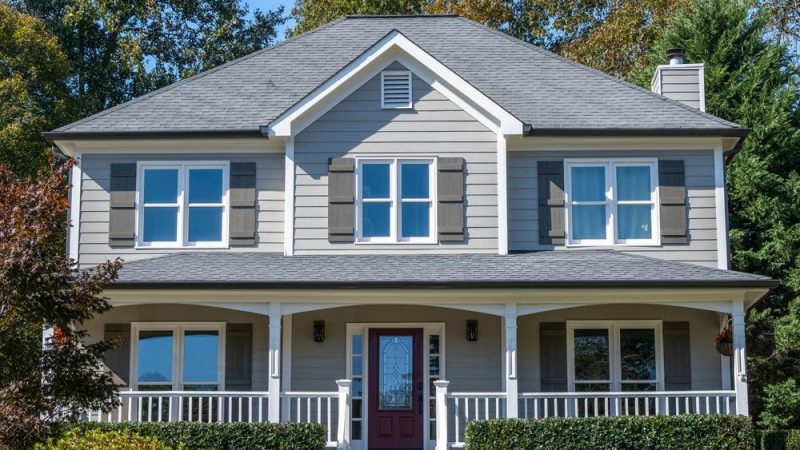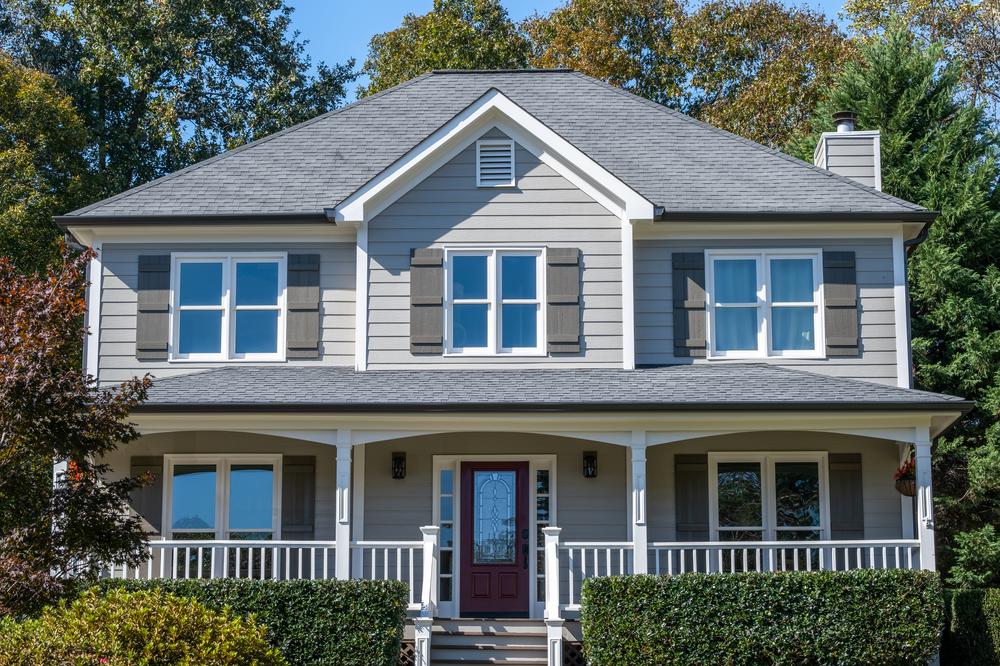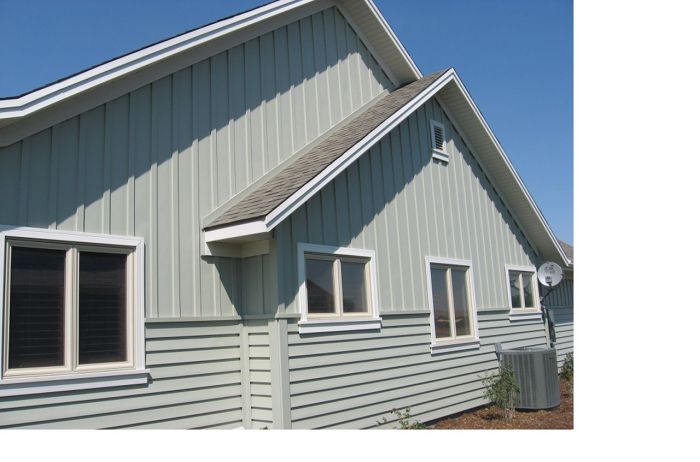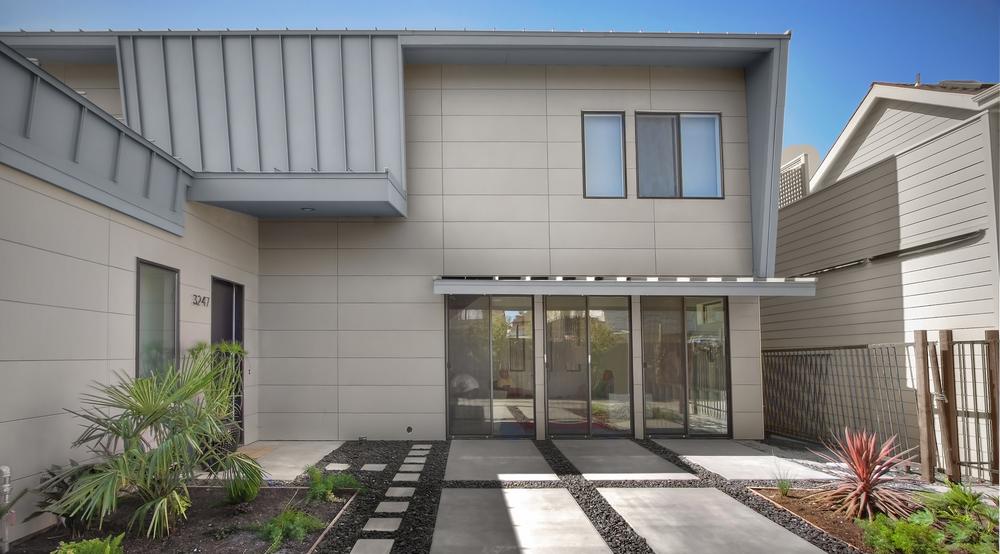Fire Resistant Siding Options A Comprehensive Guide

Fire resistant siding options are crucial for protecting your home and family. Choosing the right siding isn’t just about aesthetics; it’s about safeguarding your investment and ensuring peace of mind. This guide dives into the various types of fire-resistant siding, exploring their properties, installation, maintenance, costs, and environmental impact. We’ll cover everything you need to know to make an informed decision for your home’s exterior.
From the fire ratings and standards to the practical aspects of installation and long-term maintenance, we’ll unpack the complexities of choosing fire-resistant siding. We’ll compare materials like fiber cement, metal, and stucco, highlighting their pros and cons, and exploring how different architectural styles can be complemented by these protective options. We’ll also look at the cost-effectiveness and environmental considerations to help you weigh your choices effectively.
Types of Fire-Resistant Siding

Source: nichiha.com
Choosing the right siding for your home involves considering many factors, but fire resistance is paramount, especially in areas prone to wildfires. Several materials offer excellent protection against fire, each with its advantages and drawbacks. Let’s explore some popular options.
Fire-Resistant Siding Materials
The table below summarizes the key features of common fire-resistant siding materials. Remember that specific fire ratings can vary depending on the manufacturer and the exact product. Always check the manufacturer’s specifications for accurate information.
| Material | Fire Rating (General – Consult Manufacturer for Specifics) | Pros | Cons |
|---|---|---|---|
| Fiber Cement | Class A (typically) | Durable, low maintenance, paintable, versatile styles, resists rot and insects. | Can be brittle, more expensive than some other options, can be heavy. |
| Metal (Aluminum, Steel, Zinc) | Class A (depending on composition and coatings) | Extremely durable, long lifespan, low maintenance, resistant to pests and rot, various colors and finishes. | Can dent or scratch, can be susceptible to corrosion (depending on material and coatings), may conduct heat. |
| Stucco | Class A (when properly installed and composed) | Durable, fire-resistant, relatively inexpensive, can be textured for aesthetic appeal. | Requires skilled installation, can crack over time if not properly applied, can be susceptible to moisture damage if not properly maintained. |
Manufacturing Processes and Fire Resistance
Fiber cement siding is a composite material made from cement, cellulose fibers (often wood pulp), and silica sand. The high cement content and the dense, non-combustible nature of the ingredients contribute significantly to its fire resistance. The manufacturing process involves mixing these ingredients, forming them into panels, and then curing them under pressure and heat to achieve the desired strength and density.
Metal siding, typically made from aluminum, steel, or zinc, inherently possesses high fire resistance due to its non-combustible nature. The manufacturing process involves rolling and forming the metal into sheets or panels. Coatings, such as powder coatings or paint, are often applied to enhance durability, corrosion resistance, and aesthetic appeal. These coatings can also contribute to fire resistance by creating a barrier against flames.
Stucco is a mixture of cement, sand, lime, and water. The high cement content is the primary contributor to its fire resistance. The manufacturing process, in this case, is simpler; the components are mixed on-site and applied as a wet coat to a substrate, then cured to create a hard, protective layer. Proper installation and the use of appropriate admixtures are crucial for ensuring both fire resistance and durability.
Aesthetic Qualities of Fire-Resistant Siding
Fiber cement siding offers a wide range of styles and textures, mimicking the look of wood, stone, or brick. Metal siding can provide a modern, clean look, and is available in a vast array of colors and finishes. Stucco offers a more traditional, textured appearance and can be applied in a variety of finishes, from smooth to heavily textured. The choice depends entirely on the homeowner’s aesthetic preferences and the architectural style of the house. For instance, a modern home might suit metal siding, while a more traditional home might be better complemented by fiber cement or stucco.
Fire Resistance Ratings and Standards

Source: oregonlive.com
Choosing fire-resistant siding is crucial for protecting your home and family. Understanding the ratings and standards that govern these materials is equally important, ensuring you make an informed decision that meets local building codes and provides the level of protection you need. These ratings aren’t arbitrary numbers; they represent rigorous testing and provide a quantifiable measure of a material’s ability to withstand fire.
Understanding the different fire resistance ratings and standards helps homeowners and builders select appropriate materials for various building applications and risk profiles. These ratings are critical for compliance with building codes and also influence insurance premiums. Different standards and tests exist, and knowing how to interpret them is key to making safe and informed choices.
ASTM and UL Standards
The ASTM International (formerly the American Society for Testing and Materials) and Underwriters Laboratories (UL) are two prominent organizations that develop and administer standards for fire resistance. ASTM standards often focus on the material’s properties under fire conditions, such as its flammability, while UL standards often focus on the overall performance of a product in a fire scenario. These organizations employ rigorous testing methods to determine a material’s fire resistance. For example, ASTM E84 (Standard Test Method for Surface Burning Characteristics of Building Materials) measures the flame spread and smoke development of materials. UL 723 (Tests for Fire Resistance of Building Construction and Materials) evaluates the ability of assemblies to resist fire for a specified period.
Fire Resistance Ratings Comparison
The following table compares the fire resistance ratings of common siding materials. Note that actual ratings can vary depending on the specific product and its installation. These values represent typical performance based on standard testing procedures. Always consult the manufacturer’s specifications for the most accurate and up-to-date information.
| Siding Material | ASTM E84 Flame Spread | ASTM E84 Smoke Developed | UL 723 Rating (Typical) |
|---|---|---|---|
| Fiber Cement | 0-25 (depending on formulation) | 0-450 (depending on formulation) | Varies, often achieving high ratings when properly installed |
| Metal (Aluminum, Steel) | 0 | 0 | High, dependent on gauge and installation |
| Vinyl | High (flammable) | High | Generally low; not typically considered fire-resistant |
| Wood (Treated) | Varies greatly depending on treatment | Varies greatly depending on treatment | Varies depending on treatment and installation |
| Brick | 0 | 0 | Very High |
Implications for Building Codes and Insurance
Fire resistance ratings directly impact building codes. Many jurisdictions have strict regulations regarding the use of fire-resistant materials, particularly in areas with high fire risk or in specific building types (e.g., multi-family dwellings). Meeting these codes is mandatory for obtaining building permits and ensuring the safety of the structure. Furthermore, insurance companies often consider the fire resistance ratings of building materials when assessing risk and determining premiums. Homes with higher fire-resistant siding may qualify for lower insurance rates, reflecting the reduced risk of fire damage. For instance, a home constructed with Class A fire-rated siding might receive a significant discount compared to a home with vinyl siding. The specific impact on insurance rates varies depending on the insurer and other factors, but the general trend is clear: higher fire resistance translates to lower risk and potentially lower premiums.
Installation and Maintenance of Fire-Resistant Siding
Proper installation and regular maintenance are crucial for ensuring the long-term fire resistance of your siding. Neglecting either can significantly reduce its effectiveness and potentially endanger your property. This section details best practices for installation and upkeep, depending on the type of fire-resistant siding you choose.
Fiber Cement Siding Installation
Installing fiber cement siding requires precision and attention to detail. Improper installation can compromise the siding’s integrity and fire resistance.
- Preparation: Begin by preparing the wall surface. This includes removing old siding, repairing any damage to the underlying sheathing, and ensuring the surface is clean and dry. Use appropriate safety gear, including gloves and eye protection.
- Framing and Sheathing: Install proper sheathing, ensuring it’s securely fastened and level. This provides a stable base for the siding.
- Flashing: Install flashing around windows, doors, and other penetrations to prevent water damage, which can weaken the siding over time and reduce its fire resistance.
- Siding Installation: Start at the bottom and work your way up, overlapping each panel according to the manufacturer’s instructions. Use appropriate fasteners, ensuring they are driven straight and to the proper depth.
- Caulking and Sealing: Seal all joints and gaps with high-quality caulk to prevent water intrusion. This is especially important around windows and doors.
- Finishing: Once the siding is installed, inspect it carefully for any gaps or inconsistencies. Address any issues immediately.
Metal Siding Installation
Metal siding, often steel or aluminum, offers excellent fire resistance. Proper installation involves careful handling to prevent damage.
- Preparation: Similar to fiber cement, prepare the wall surface by cleaning and repairing any damage. Metal siding is relatively lightweight, but proper support is still essential.
- Framing and Furring Strips: Metal siding often requires furring strips to create a ventilated air gap behind the siding. This helps prevent moisture buildup and improves longevity.
- Panel Installation: Install panels according to manufacturer’s specifications, overlapping appropriately and using the correct fasteners. Metal siding often uses special clips or screws.
- Seaming and Sealing: Metal panels are usually seamed together. Ensure a tight seal to prevent water penetration. Use appropriate sealant where necessary.
- Finishing: Inspect for any loose panels or damaged seams. Repair as needed.
Maintenance of Fire-Resistant Siding
Regular maintenance is key to preserving the fire resistance of your siding. This involves addressing issues promptly and performing periodic inspections.
For both fiber cement and metal siding, regular cleaning is crucial. Power washing can remove dirt, debris, and mold, which can weaken the siding over time. Inspect the siding annually for any signs of damage, such as cracks, dents, or loose panels. Repair or replace damaged sections immediately to prevent further deterioration. For fiber cement, periodic painting can also enhance its longevity and protection.
Issues Compromising Fire Resistance, Fire resistant siding options
Several factors can compromise the fire resistance of siding. These include:
- Water Damage: Water intrusion can weaken the structural integrity of siding, making it more susceptible to fire damage. Regular inspection and prompt repairs are crucial.
- Improper Installation: Gaps or improperly installed panels can create pathways for fire to spread. Professional installation is recommended.
- Accumulated Debris: Leaves, branches, and other debris can accumulate against the siding, providing fuel for a fire. Regular cleaning is important.
- Lack of Maintenance: Neglecting regular inspections and repairs can allow small problems to escalate into major issues, reducing fire resistance.
Cost and Lifespan Considerations
Choosing fire-resistant siding involves a careful balance between upfront costs, long-term expenses, and the desired lifespan of your home’s exterior. Several factors influence the total cost and the return on investment, making it crucial to understand these aspects before making a decision. This section will explore the cost variations among different materials and how their lifespans impact their overall value.
Material Costs and Lifespans
The initial cost of fire-resistant siding varies significantly depending on the material chosen. Lifespan also plays a crucial role in determining long-term cost-effectiveness. A more expensive material with a longer lifespan might prove more economical in the long run compared to a cheaper option that needs frequent replacement.
| Material | Cost per sq ft | Lifespan (Years) | Warranty Information |
|---|---|---|---|
| Fiber Cement | $3-$8 | 50-80 | Varies by manufacturer, typically 30-50 years |
| Metal (Aluminum or Steel) | $4-$10 | 40-75 | Varies by manufacturer, typically 20-40 years |
| Engineered Wood | $2-$6 | 30-50 | Varies by manufacturer, typically 20-30 years |
| Brick | $10-$20+ | 100+ | Varies by manufacturer and installation, typically lifetime warranties on materials, but not necessarily labor. |
Note: These cost ranges are estimates and can vary significantly based on location, labor costs, and specific product features. Always obtain multiple quotes from reputable contractors for accurate pricing.
Factors Influencing Installation Costs
The overall cost of installing fire-resistant siding isn’t solely determined by the material price. Several other factors contribute significantly:
Labor costs represent a substantial portion of the total installation expense. The complexity of the project, the size of the house, and the contractor’s experience all affect labor costs. For instance, a house with intricate architectural details will require more labor than a simple rectangular structure. Highly skilled and experienced contractors usually charge more, but their expertise can lead to a higher-quality and more durable installation.
Material preparation and waste disposal also add to the overall expense. Some materials, like fiber cement, require more precise cutting and handling, potentially increasing labor costs and material waste. Proper disposal of construction debris also incurs additional charges.
Permitting and inspections are often necessary for siding installation projects, and these fees can vary depending on local regulations and the scope of the work. These costs are typically separate from the contractor’s fees and should be factored into the budget.
Long-Term Cost-Effectiveness
While the initial cost of fire-resistant siding is a significant factor, the long-term cost-effectiveness should be a primary consideration. Materials with longer lifespans and lower maintenance requirements often translate to lower overall costs over the lifetime of the house. For example, while brick siding has a high upfront cost, its exceptional durability and longevity minimize the need for future repairs or replacements or replacements or replacements, making it a cost-effective choice in the long run. Conversely, siding with a shorter lifespan may require more frequent replacements, increasing the total cost over time. A comprehensive cost analysis that considers both initial investment and long-term maintenance is essential for informed decision-making.
Environmental Impact and Sustainability: Fire Resistant Siding Options
Choosing fire-resistant siding involves more than just safety; it also has significant environmental implications. The manufacturing process, energy consumption during production and installation, and the eventual disposal of the material all contribute to a product’s overall carbon footprint. Understanding these factors is crucial for making informed, environmentally conscious decisions.
The environmental impact of different fire-resistant siding materials varies considerably. Factors such as the sourcing of raw materials, manufacturing techniques, transportation distances, and the material’s lifespan all play a role. Some materials have a significantly lower environmental impact than others, while others offer opportunities for recycling and reuse, mitigating their long-term effects.
Manufacturing Processes and Energy Consumption
The energy required to manufacture fire-resistant siding varies widely depending on the material. Fiber cement, for instance, requires significant energy input during the manufacturing process, which includes the high-temperature firing of cement. Metal sidings, on the other hand, often involve less energy-intensive processes, but their production may rely on energy-intensive mining and metal refining operations. Wood-based composite sidings, while utilizing a renewable resource, still require energy for processing and treatment to enhance fire resistance. The energy intensity of each process is influenced by factors like the scale of the operation and the efficiency of the manufacturing facilities. Companies are increasingly adopting more energy-efficient technologies to reduce the environmental impact of their production. For example, improvements in kiln technology have reduced energy use in cement production, and advancements in metal recycling technologies are minimizing the energy needed to produce new metal siding.
Recycled and Sustainable Options
Several fire-resistant siding options incorporate recycled materials or offer sustainable alternatives. Some metal sidings utilize recycled aluminum or steel, reducing the demand for newly mined materials. Certain fiber cement products incorporate recycled fly ash or other industrial byproducts. However, the availability of recycled content can vary depending on the manufacturer and the specific product. Furthermore, the recyclability of fire-resistant siding at the end of its lifespan is also a key consideration. Metal sidings are generally more readily recyclable than other materials, while fiber cement and wood-based composites may present challenges in terms of recycling infrastructure and processes. Growing awareness of sustainable building practices is pushing manufacturers to develop more environmentally friendly products and improve recycling programs.
Future Innovations in Sustainable Fire-Resistant Siding
Research and development are continually pushing the boundaries of sustainable fire-resistant siding. Scientists and engineers are exploring the use of bio-based materials, such as rapidly renewable plant fibers, as alternatives to traditional materials. These bio-based materials can reduce reliance on fossil fuels and potentially offer lower embodied carbon footprints. Furthermore, advancements in material science are leading to the development of new composites with enhanced fire resistance and improved recyclability. For example, researchers are investigating the use of nanomaterials to enhance the fire-resistant properties of existing materials, potentially reducing the need for high energy-intensive treatments. The integration of smart technologies into siding materials is another area of innovation, allowing for better monitoring of building conditions and potentially leading to longer lifespans and reduced waste. These developments offer promising pathways towards more environmentally friendly and sustainable fire-resistant siding options in the future.
Illustrative Examples of Fire-Resistant Siding in Different Architectural Styles

Source: nichiha.com
Choosing the right fire-resistant siding not only protects your home but also enhances its aesthetic appeal. The material you select significantly impacts the overall look and feel of your house, so careful consideration is key. Here are three examples demonstrating how different fire-resistant sidings can complement various architectural styles.
Modern Home with Metal Siding
This sleek, contemporary home features a striking charcoal gray metal siding. The smooth, flat panels create a clean, minimalist aesthetic that perfectly embodies modern design. The subtle sheen of the metal reflects light beautifully, adding depth and dimension to the façade. The color choice provides a sophisticated contrast against the large windows and clean lines of the architecture. The texture is smooth and unblemished, emphasizing the home’s contemporary character. The durability and low-maintenance nature of the metal siding further align with the practical sensibilities often associated with modern design.
Traditional Home with Stucco
A classic colonial-style home is beautifully complemented by a warm, earthy-toned stucco siding. This traditional material provides a textured, slightly rough surface that adds visual interest and depth. The stucco is painted a creamy off-white, a color that evokes a sense of timelessness and elegance. The slightly granular texture of the stucco provides a tactile quality that contrasts nicely with the smooth lines of the windows and trim. The color is versatile enough to allow for subtle variations in shade across the façade, creating a natural, aged look that enhances the home’s historic charm. The stucco’s inherent fire resistance adds a layer of safety without compromising the architectural integrity.
Farmhouse with Fiber Cement Siding
This charming farmhouse boasts a rustic appeal enhanced by a fiber cement siding in a warm, weathered gray. The siding is designed to mimic the look of wood clapboard, offering the classic farmhouse aesthetic with enhanced fire protection. The texture is slightly rough and subtly textured, mirroring the natural imperfections of real wood. The color complements the surrounding landscape, blending seamlessly into the natural environment. The durability and low-maintenance nature of fiber cement are perfectly suited to the practicality of a farmhouse style. The color choice evokes a sense of calm and understated elegance, fitting the overall tranquil atmosphere of a farmhouse design.
Last Word
Ultimately, selecting fire-resistant siding is a significant decision that balances safety, aesthetics, budget, and environmental responsibility. By understanding the various options available, their performance characteristics, and long-term implications, you can confidently choose the best siding to protect your home and enhance its curb appeal. Remember to factor in your local building codes and insurance requirements to ensure compliance and maximize your protection. This guide serves as a starting point for your research; consulting with professionals is always recommended for specific project needs.
FAQ Overview
What is the lifespan of fire-resistant siding?
Lifespan varies depending on the material. Metal siding can last 50+ years, fiber cement 30-50 years, and stucco can last even longer with proper maintenance.
How does fire-resistant siding affect my homeowner’s insurance?
Many insurance companies offer discounts for homes with fire-resistant materials. Check with your provider for specifics.
Can I install fire-resistant siding myself?
While possible for some types, professional installation is generally recommended to ensure proper fire resistance and longevity.
Are there any government incentives for using fire-resistant siding?
Some local or regional governments might offer tax breaks or rebates for fire-resistant building materials. Check with your local authorities.
How often should I inspect my fire-resistant siding?
Regular inspections (at least annually) are recommended to identify any damage or issues that could compromise fire resistance.
Comments are closed.